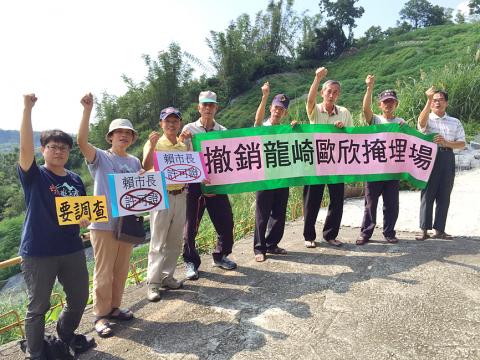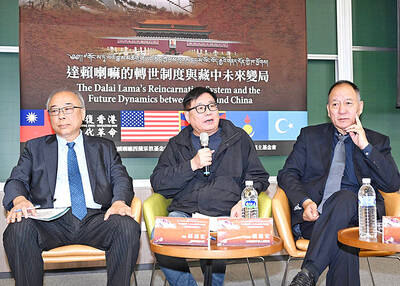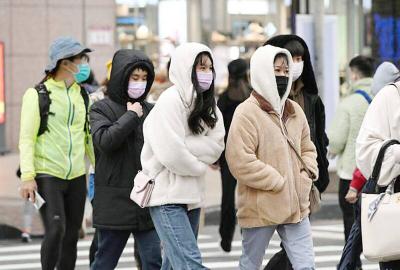Environmentalists yesterday protested against a planned landfill in Tainan’s Longci District (龍崎), saying the site is prone to earthquakes and landslides, which could cause pollutants to leach into rivers and groundwater.
The Ousin landfill project was approved by the Environmental Protection Administration (EPA) in 2003 and plans to develop 41.19 hectares to bury 18.7 million tonnes of industrial waste.
The Tainan City Government has not issued the developer a construction permit because of protests by local residents.

Photo: Wu Chun-feng, Taipei Times
Tainan Mayor William Lai (賴清德) reached an agreement with the Executive Yuan in 2011, stating that the development could not begin without the approval of a majority of residents.
Following a long hiatus, environmental activists yesterday urged the city government not to issue a construction permit and the EPA to revoke its approval, because new geological studies suggested the area was not suitable for the development.
Following a magnitude 6.4 earthquake on Feb. 6, the Central Geological Survey and National Taiwan University geology professor Chen Wen-shan (陳文山) said that a fault line across Longci was “very active,” Tainan Community University professor Huang Huan-chang (黃煥彰) said.
The earthquake elevated the planned site by 14cm and significant ground displacement caused by the earthquake can be found in Longci, Huang said.
Mud volcanoes found in the area suggest that it is not geologically stable, but rich in groundwater. Building a landfill in the area might cause pollutants to leak into waterways, Taiwan Water Resources Protection Union spokeswoman Chen Jiau-hua (陳椒華) said.
The planned site is upstream of the Niupu River (牛埔溪), a tributary of the Erren River (二仁溪), which is a major source of agricultural water for the city, Chen said.
“Although Lai made an agreement with the Executive Yuan, the city government permitted the developer to conduct soil and waterworks, which were generally understood to be pre-construction works,” Huang said.
The planned site is a badland, which is easily eroded and holds little water or vegetation, but the Council of Agriculture spent more than NT$80 million (US$2.5 million) building dams and growing vegetation, making the area a home to a variety of animal and plant species, Tainan City Environmental Protection Alliance director Huang An-tiao (黃安調) said.
“The badland in Longci is a world-class landscape and a geological classroom, and the city government should use it to develop tourism rather than pollution. It would be unreasonable to build a landfill in a disaster-prone area where the government has spent so much money carrying out conservation works,” he said.

ALIGNED THINKING: Taiwan and Japan have a mutual interest in trade, culture and engineering, and can work together for stability, Cho Jung-tai said Taiwan and Japan are two like-minded countries willing to work together to form a “safety barrier” in the Indo-Pacific region, Premier Cho Jung-tai (卓榮泰) yesterday said at the opening ceremony of the 35th Taiwan-Japan Modern Engineering and Technology Symposium in Taipei. Taiwan and Japan are close geographically and closer emotionally, he added. Citing the overflowing of a barrier lake in the Mataian River (馬太鞍溪) in September, Cho said the submersible water level sensors given by Japan during the disaster helped Taiwan monitor the lake’s water levels more accurately. Japan also provided a lot of vaccines early in the outbreak of the COVID-19 pandemic,

Kaohsiung Mayor Chen Chi-mai (陳其邁) on Monday announced light shows and themed traffic lights to welcome fans of South Korean pop group Twice to the port city. The group is to play Kaohsiung on Saturday as part of its “This Is For” world tour. It would be the group’s first performance in Taiwan since its debut 10 years ago. The all-female group consists of five South Koreans, three Japanese and Tainan’s Chou Tzu-yu (周子瑜), the first Taiwan-born and raised member of a South Korean girl group. To promote the group’s arrival, the city has been holding a series of events, including a pop-up

TEMPORAL/SPIRITUAL: Beijing’s claim that the next Buddhist leader must come from China is a heavy-handed political maneuver that will fall flat-faced, experts said China’s requirement that the Dalai Lama’s reincarnation to be born in China and approved by Beijing has drawn criticism, with experts at a forum in Taipei yesterday saying that if Beijing were to put forth its own Dalai Lama, the person would not be recognized by the Tibetan Buddhist community. The experts made a remarks at the two-day forum hosted by the Tibet Religious Foundation of His Holiness the Dalai Lama titled: “The Snow Land Forum: Finding Common Ground on Tibet.” China says it has the right to determine the Dalai Lama’s reincarnation, as it claims sovereignty over Tibet since ancient times,

Temperatures in some parts of Taiwan are expected to fall sharply to lows of 15°C later this week as seasonal northeasterly winds strengthen, the Central Weather Administration (CWA) said today. It is to be the strongest cold wave to affect northern Taiwan this autumn, while Chiayi County in the southwest and some parts of central Taiwan are likely to also see lower temperatures due to radiational cooling, which occurs under conditions of clear skies, light winds and dry weather, the CWA said. Across Taiwan, temperatures are to fall gradually this week, dropping to 15°C to 16°C in the early hours of Wednesday